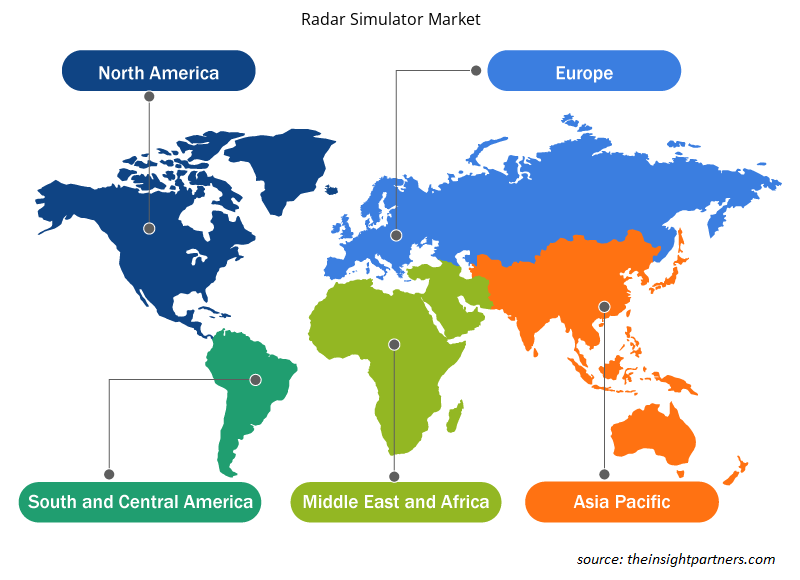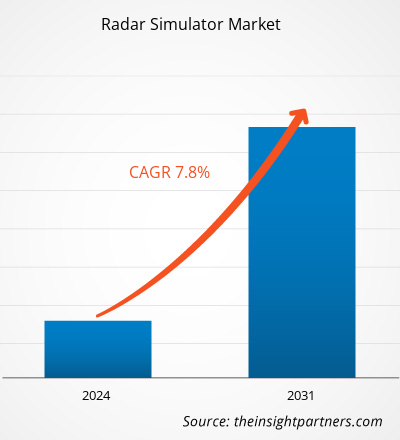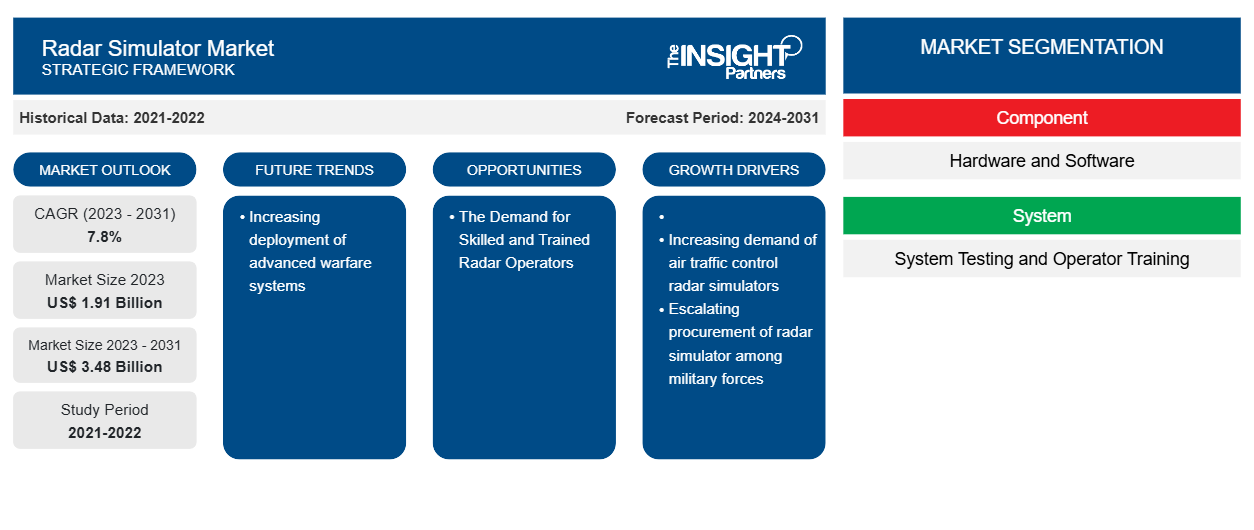Si prevede che la dimensione del mercato dei simulatori radar raggiungerà i 3,48 miliardi di dollari entro il 2031, rispetto agli 1,91 miliardi di dollari del 2023. Si prevede che il mercato registrerà un CAGR del 7,8% nel periodo 2023-2031. È probabile che l'aumento dell'impiego di sistemi di guerra avanzati rimanga una tendenza chiave nel mercato.
Analisi di mercato dei simulatori radar
I principali stakeholder nell'ecosistema del mercato globale dei simulatori radar includono fornitori di materie prime e componenti, produttori e sviluppatori di simulatori radar, integratori di sistema e utenti finali. I fornitori di componenti e hardware offrono numerose parti e componenti per i produttori di simulatori radar. Per produrre simulatori radar vengono utilizzati diversi tipi di componenti, tra cui antenna, ricevitori, generatori di forme d'onda e microcontrollori . La fornitura tempestiva di tutti questi componenti è fondamentale per un funzionamento efficiente negli impianti di produzione di simulatori radar. Pertanto, qualsiasi impatto operativo su questi fornitori di componenti ha un impatto diretto sul mercato dei simulatori radar.
Panoramica del mercato dei simulatori radar
I principali stakeholder nella catena del valore sono i produttori di simulatori radar e gli sviluppatori di software. Offrono il prodotto finale integrato ai settori di utilizzo finale. I principali attori che operano nel mercato includono Collins Aerospace; L3Harris Technologies, Inc.; Mercury Systems, Inc.; Ultra Electronics Holdings plc; e ARI Simulation. Gli integratori di sistema che operano nel mercato integrano le soluzioni hardware e software per offrire il prodotto finale agli utenti finali nel mercato globale dei simulatori radar.
Personalizza questo report in base alle tue esigenze
Riceverai la personalizzazione gratuita di qualsiasi report, comprese parti di questo report, o analisi a livello nazionale, pacchetto dati Excel, oltre a usufruire di grandi offerte e sconti per start-up e università
-
Scopri le principali tendenze di mercato in questo rapporto.Questo campione GRATUITO includerà analisi di dati che spaziano dalle tendenze di mercato alle stime e alle previsioni.
Driver e opportunità del mercato dei simulatori radar
Aumento dell'acquisto di simulatori radar tra le forze militari
Le preoccupazioni relative alla sicurezza nei luoghi pubblici, ai confini nazionali e sulla terraferma, nei porti navali e nelle basi dell'aeronautica militare aumentano costantemente in tutto il mondo. Gestire e controllare efficacemente le minacce aeree, navali o terrestri con l'aiuto dei sistemi radar è diventato un importante paradigma per le autorità militari e di sicurezza di ogni regione del mondo. I sistemi radar e i simulatori radar stanno guadagnando sempre più popolarità per garantire la sicurezza delle operazioni e del personale militare, nonché un addestramento efficiente per gli operatori radar. I simulatori radar vengono acquistati da molti paesi come Stati Uniti, Cina, India, Giappone, Australia, Canada, Germania, Francia e Regno Unito, tra gli altri, per rafforzare le rispettive forze militari e addestrare gli operatori a combattere le minacce degli attacchi aerei avanzati che si verificano con frequenza. I simulatori radar aiutano ulteriormente i funzionari militari a ideare contromisure in caso di attacchi da parte di minacce non identificate. L'acquisto di simulatori radar è aumentato nei settori militari in vari paesi e i governi di questi paesi stanno proponendo budget di spesa militare più elevati per aiutare i settori militare e della difesa ad acquistare sistemi radar e simulatori radar più avanzati.
La domanda di operatori radar qualificati e formati
L'ascesa delle moderne torri di controllo del traffico aereo e delle tecnologie militari avanzate ha creato una domanda crescente di operatori in grado di operare con le moderne apparecchiature di terra e la tecnologia militare. I simulatori radar gestiscono grandi volumi di dati di segnali radar non elaborati per scoprire minacce aeree non identificate, minacce navali o qualsiasi altro oggetto all'interno dei perimetri definiti. C'è stato un aumento nell'adozione di simulatori radar tra le forze militari e di difesa in vari paesi, il che ha innescato grandi investimenti per lo sviluppo e la ricerca della tecnologia di simulazione radar. Ciò ha dato origine alla domanda di operatori radar altamente qualificati e formati in aeroporti, basi aeree, navi militari, navi cargo militari e porti navali. Il fatto che questa domanda dovrebbe aumentare nei prossimi anni rappresenta un'enorme opportunità di crescita per i principali attori del mercato e per il mercato complessivo dei simulatori radar nei prossimi anni. Poiché si prevede che i settori aerospaziale e della difesa cresceranno durante il periodo di previsione, si prevede che ciò aumenterà ulteriormente la domanda di operatori radar qualificati, formati ed esperti per salvaguardare lo spazio aereo, le vie d'acqua e i confini terrestri dei paesi. Pertanto, si prevede che la domanda di operatori radar qualificati e formati nei settori dell'aviazione commerciale e della difesa, insieme alle forze navali e alle forze militari di terra, darà impulso al mercato dei simulatori radar nel prossimo futuro.
Analisi della segmentazione del rapporto di mercato del simulatore radar
I segmenti chiave che hanno contribuito alla derivazione dell'analisi di mercato dei simulatori radar sono componenti, sistemi e applicazioni.
- In base al componente, il mercato dei simulatori radar è segmentato in hardware e software. Il segmento hardware ha detenuto una quota di mercato maggiore nel 2023.
- In base al sistema, il mercato dei simulatori radar è segmentato in test di sistema e formazione degli operatori. Il segmento della formazione degli operatori ha detenuto una quota di mercato maggiore nel 2023.
- In base all'applicazione, il mercato dei simulatori radar è segmentato in militare e commerciale. Il segmento commerciale ha detenuto una quota di mercato maggiore nel 2023.
Analisi della quota di mercato dei simulatori radar per area geografica
L'ambito geografico del rapporto di mercato sui simulatori radar è suddiviso principalmente in cinque regioni: Nord America, Europa, Asia Pacifico, Medio Oriente e Africa e Sud America.
Il Nord America ha dominato il mercato nel 2023, seguito da Europa e regioni dell'Asia Pacifica. Inoltre, è probabile che anche l'Asia Pacifica assista al CAGR più elevato nei prossimi anni. Gli Stati Uniti hanno dominato il mercato dei simulatori radar del Nord America nel 2023. Ciò è dovuto principalmente all'adozione precoce della tecnologia dei simulatori radar. Inoltre, gli Stati Uniti hanno il budget per la difesa più grande al mondo e una grande quantità di budget viene destinata all'adozione e all'approvvigionamento di sistemi d'arma aggiornati. Ciò contribuisce alla domanda di simulatori radar in tutto il paese. Anche il crescente numero di velivoli nell'aeronautica e nell'esercito degli Stati Uniti funge da fattore di supporto per la crescita del mercato nel paese. Anche il crescente utilizzo di simulatori radar per simulare accuratamente il terreno del mondo reale, nonché modelli meteorologici e obiettivi negli Stati Uniti sta guidando la crescita del mercato nel paese. La crescente domanda di simulatori radar nuovi e avanzati negli Stati Uniti è un fattore importante che guida la crescita del mercato. Inoltre, i simulatori radar che offrono le capacità per la simulazione del radar meteorologico stanno guadagnando popolarità negli Stati Uniti. L'uso diffuso di simulatori radar per scopi di addestramento commerciale e insegnamento di piloti e personale di supporto aereo è in aumento nel paese. Inoltre, l'adozione di simulatori radar per la creazione di simulazioni complesse multi-radar e multi-bersaglio, consentendo così di testare i sistemi di dati RADAR, aumenta anche la crescita del mercato negli Stati Uniti. La presenza di vari attori chiave del mercato come Cambridge Pixel Ltd (Stati Uniti), Harris Corporation (Stati Uniti), Buffalo Computer Graphics (Stati Uniti), Mercury Systems, Inc. (Stati Uniti), Textron Systems (Stati Uniti) e Rockwell Collins (Stati Uniti) aiuta la crescita del mercato nel paese.
Approfondimenti regionali sul mercato dei simulatori radar
Le tendenze regionali e i fattori che influenzano il mercato dei simulatori radar durante il periodo di previsione sono stati ampiamente spiegati dagli analisti di Insight Partners. Questa sezione discute anche i segmenti e la geografia del mercato dei simulatori radar in Nord America, Europa, Asia Pacifico, Medio Oriente e Africa e America meridionale e centrale.

- Ottieni i dati specifici regionali per il mercato dei simulatori radar
Ambito del rapporto di mercato del simulatore radar
| Attributo del report | Dettagli |
|---|---|
| Dimensioni del mercato nel 2023 | 1,91 miliardi di dollari USA |
| Dimensioni del mercato entro il 2031 | 3,48 miliardi di dollari USA |
| CAGR globale (2023-2031) | 7,8% |
| Dati storici | 2021-2022 |
| Periodo di previsione | 2024-2031 |
| Segmenti coperti |
Per componente
|
| Regioni e Paesi coperti |
America del Nord
|
| Leader di mercato e profili aziendali chiave |
|
Densità degli attori del mercato: comprendere il suo impatto sulle dinamiche aziendali
Il mercato del Radar Simulator Market sta crescendo rapidamente, spinto dalla crescente domanda degli utenti finali dovuta a fattori quali l'evoluzione delle preferenze dei consumatori, i progressi tecnologici e una maggiore consapevolezza dei vantaggi del prodotto. Con l'aumento della domanda, le aziende stanno ampliando le loro offerte, innovando per soddisfare le esigenze dei consumatori e capitalizzando sulle tendenze emergenti, il che alimenta ulteriormente la crescita del mercato.
La densità degli operatori di mercato si riferisce alla distribuzione di aziende o società che operano in un particolare mercato o settore. Indica quanti concorrenti (operatori di mercato) sono presenti in un dato spazio di mercato in relazione alle sue dimensioni o al valore di mercato totale.
Le principali aziende che operano nel mercato dei simulatori radar sono:
- Tecnologie Adacel limitate
- Simulazione ARI
- Grafica computerizzata Buffalo
- Cambridge Pixel Ltd.
- L3Harris Technologies, Inc.
- Sistemi Mercury Inc.
Disclaimer : le aziende elencate sopra non sono classificate secondo un ordine particolare.

- Ottieni la panoramica dei principali attori del mercato dei simulatori radar
Notizie e sviluppi recenti sul mercato dei simulatori radar
Il mercato dei simulatori radar viene valutato raccogliendo dati qualitativi e quantitativi dopo la ricerca primaria e secondaria, che include importanti pubblicazioni aziendali, dati associativi e database. Di seguito sono elencati alcuni degli sviluppi nel mercato dei simulatori radar:
- Il contratto COBRA Radar Environment Simulator (CRES) è stato firmato tra HENSOLDT Sensors GmbH e OCCAR per conto di Germania e Francia. (Fonte: OCCAR, comunicato stampa, giugno 2021)
- Micro Nav è orgogliosa di annunciare l'assegnazione di un contratto da NATS per fornire funzionalità di simulazione BEST Tower e Radar negli aeroporti di Aberdeen, Glasgow e Southampton. Il contratto include l'aggiornamento degli attuali sistemi BEST 2D Tower negli aeroporti di Aberdeen e Glasgow alla funzionalità di simulazione 3D tower e la fornitura di un simulatore BEST 3D Tower completamente nuovo all'aeroporto di Southampton. (Fonte: Micro Nav, comunicato stampa, agosto 2023)
Copertura e risultati del rapporto di mercato sui simulatori radar
Il rapporto "Dimensioni e previsioni del mercato dei simulatori radar (2021-2031)" fornisce un'analisi dettagliata del mercato che copre le seguenti aree:
- Dimensioni e previsioni del mercato dei simulatori radar a livello globale, regionale e nazionale per tutti i segmenti di mercato chiave coperti dall'ambito
- Tendenze del mercato dei simulatori radar e dinamiche di mercato come conducenti, restrizioni e opportunità chiave
- Analisi dettagliata delle cinque forze di Porter
- Analisi di mercato del simulatore radar che copre le principali tendenze del mercato, il quadro globale e regionale, i principali attori, le normative e i recenti sviluppi del mercato
- Analisi del panorama industriale e della concorrenza che copre la concentrazione del mercato, l'analisi della mappa di calore, i principali attori e gli sviluppi recenti per il mercato dei simulatori radar
- Profili aziendali dettagliati
- Analisi storica (2 anni), anno base, previsione (7 anni) con CAGR
- Analisi PEST e SWOT
- Valore/volume delle dimensioni del mercato - Globale, Regionale, Nazionale
- Industria e panorama competitivo
- Set di dati Excel
Report recenti
Rapporti correlati
Testimonianze
Motivo dell'acquisto
- Processo decisionale informato
- Comprensione delle dinamiche di mercato
- Analisi competitiva
- Analisi dei clienti
- Previsioni di mercato
- Mitigazione del rischio
- Pianificazione strategica
- Giustificazione degli investimenti
- Identificazione dei mercati emergenti
- Miglioramento delle strategie di marketing
- Aumento dell'efficienza operativa
- Allineamento alle tendenze normative























 Ottieni un campione gratuito per - Mercato dei simulatori radar
Ottieni un campione gratuito per - Mercato dei simulatori radar